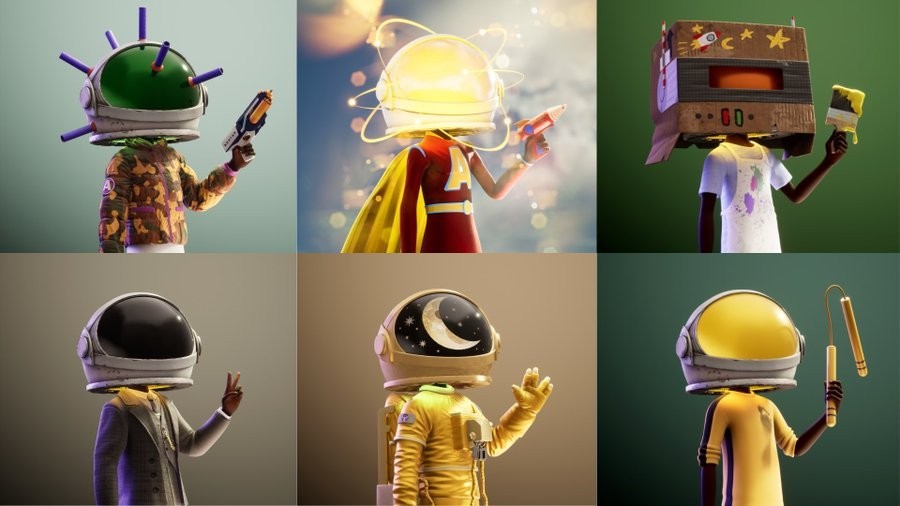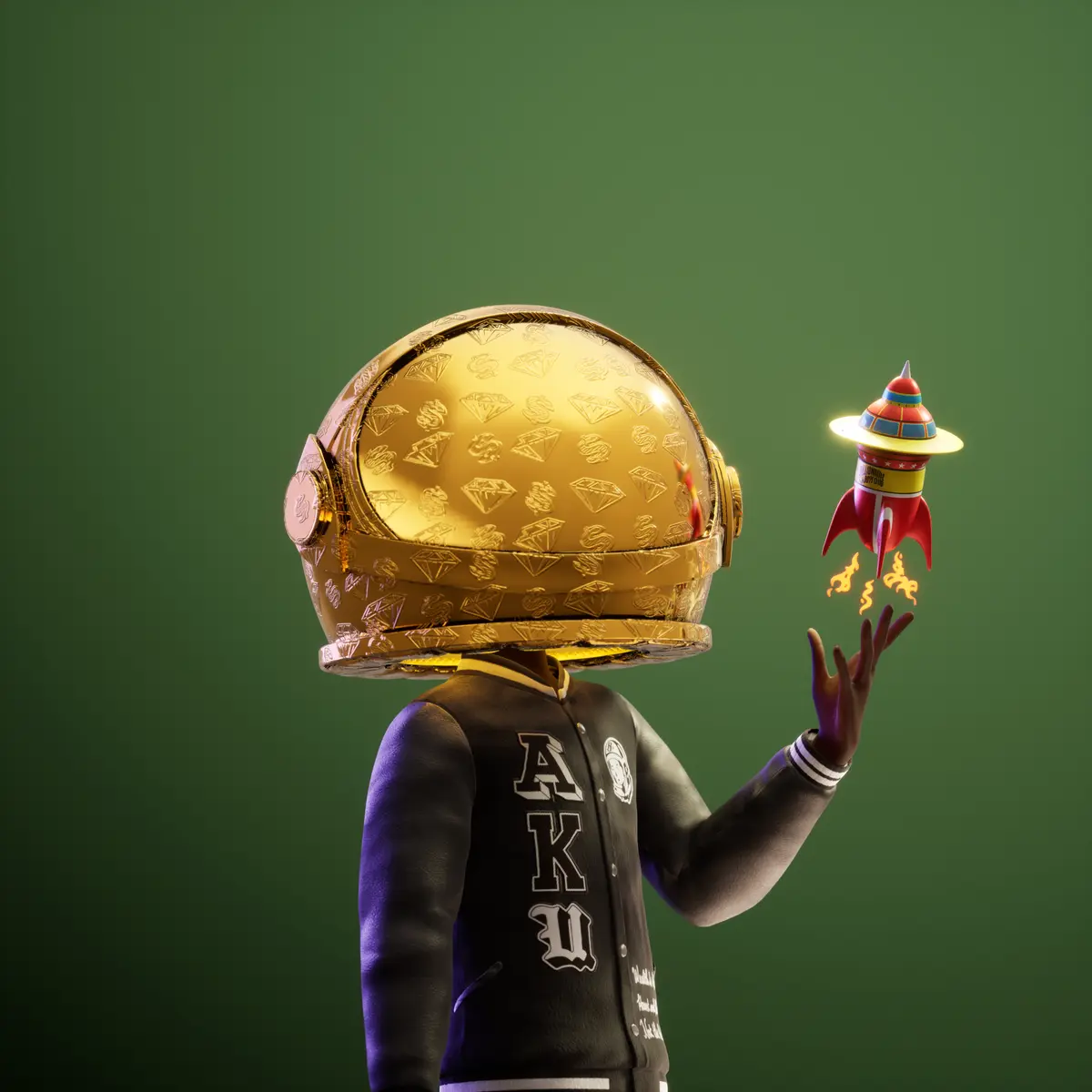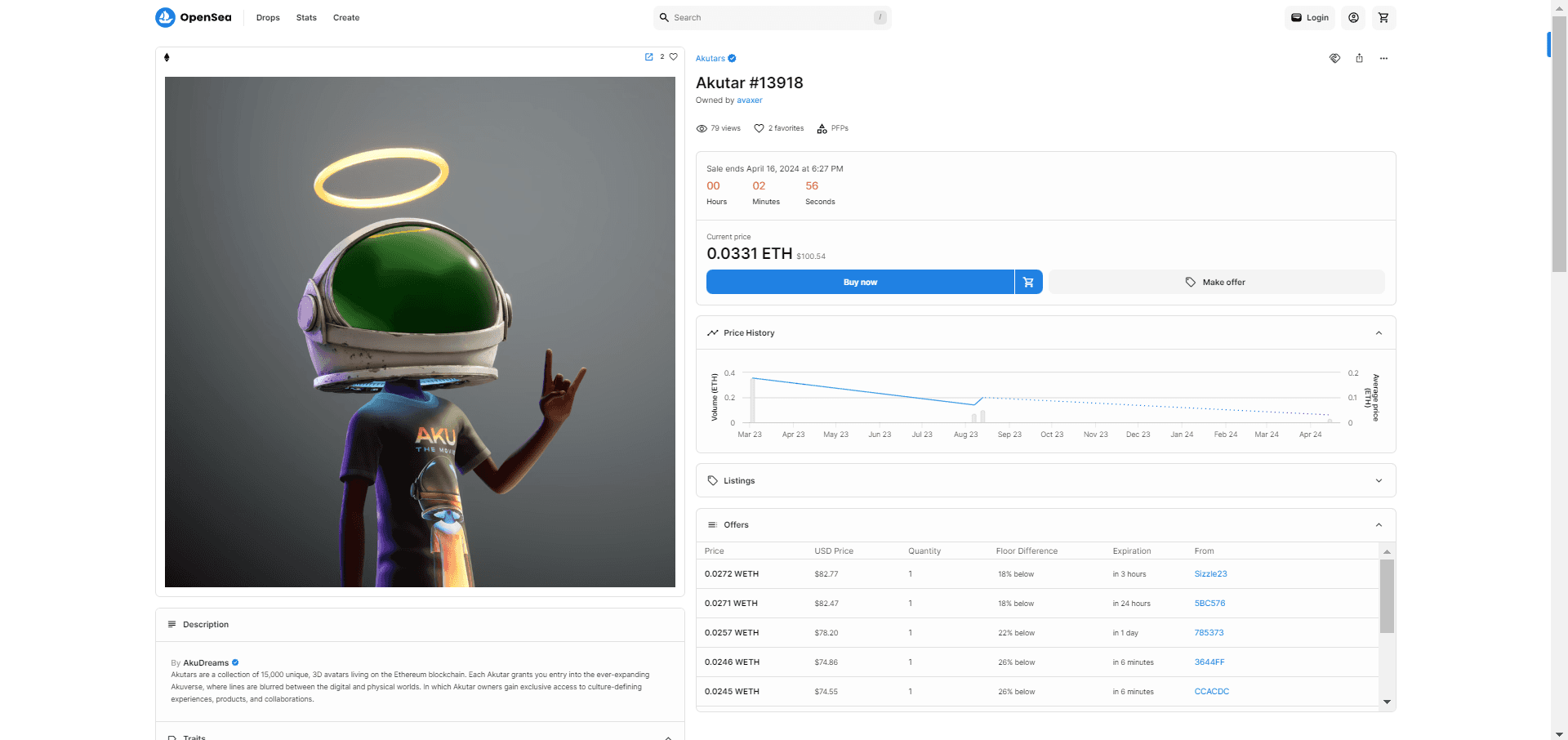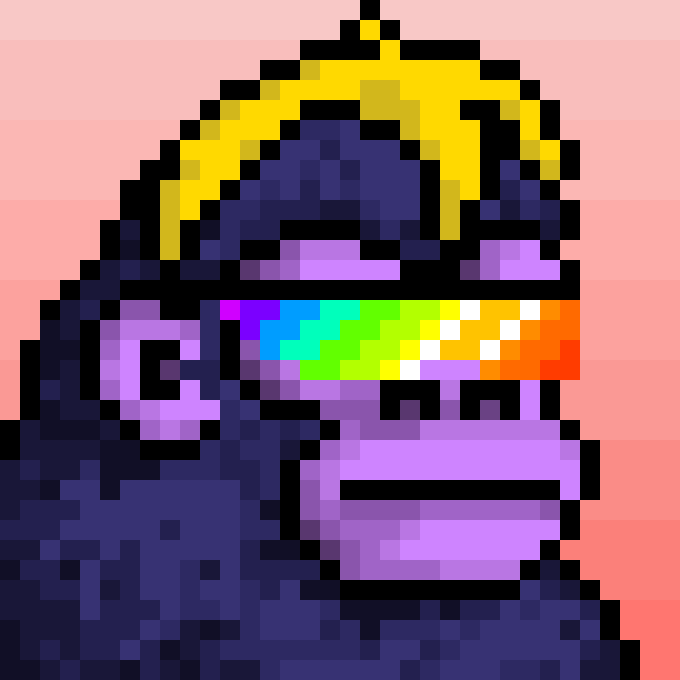TL;DR: With a new update or NFT collection being released almost every day, it’s clear the crypto ecosystem is constantly evolving. Akutars is one of the NFT collections paving the road to the digital universe — but it’s just the beginning. Knowing what brought it here and why it was created will lead you to make better decisions when investing or simply interacting with Akutars.
In this article, we’re gonna dive into the Akutars lore, answer all the Akutars related questions and even more. Prepare yourself for a fantasy story and a journey to the future of Akutars!
What is Akutars?
Akutars is an NFT collection of 15,000 3D characters that live on the Ethereum blockchain.
At the heart of Akutars is Micah Johnson, the imaginative brain behind this incredible journey. It all began with a simple yet profound question from a young boy: "Can astronauts be black?" This innocent curiosity sparked a vibrant creative vision in Micah's mind, setting the stage for the magical world of Akutars.
Get ready to dive into a story that's all about curiosity, imagination, and the belief that dreams can take us beyond the stars. Let's explore this exciting adventure where art and exploration collide!

Once upon a time, in a digital wonderland filled with endless possibilities, there was a young hero named Aku. Aku was no ordinary hero; he wore a magical helmet that gave him the power to embark on thrilling adventures through the vast metaverse. His purpose was extraordinary: to connect with the dreams of children far and wide, and to inspire them to chase those dreams with unbridled passion and enthusiasm. With a heart brimming with boundless creativity and infectious energy, Aku set out to ignite the spark of belief in every child he encountered.

Crafted using Unreal Engine 5, these premium Akus stand out as some of the most intricately designed NFTs, boasting a 3D projection.
The "Aku" NFTs are brief yet captivating 3D video clips that take you on a journey through Aku's dreams and digital adventures.
Owning an NFT is different than screenshotting a JPEG - just like holding an original Rembrandt is more valuable than owning a replica. As their name suggests, NFTs are non-fungible by design. This is different from digital tokens like Bitcoin and Ethereum.
Fungible assets can be exchanged for another asset of the same type, much like BTC, ETH, or even fiat. NFTs, on the other hand, are unique assets where their ownership details are documented on the blockchain, ensuring digital scarcity and unique attributes for each asset.
But how exactly is digital scarcity being enforced?
The concept of NFTs first emerged in 2012 with the creation of Colored Coins, which could be used to represent real-world assets on the blockchain. However, Colored Coins only worked in a permitted environment, making it more similar to a database than anything else.
As the crypto industry became more popular, people have continued to experiment with the idea of a digitally scarce asset. This led to the creation of ERC-721 and ERC-1155.
The ERC-721 standard is like a set of rules for making NFTs. These actions help in making special tokens with their unique information, making them different from one another.
Behind the scenes, ERC-721 smart contracts keep a list of who owns which token, making it safe to pass tokens from one person to another. The contract also keeps count of how many tokens there are altogether and how many each person has.
As previously mentioned, Akutars NFTs are secured by the Ethereum blockchain. Ownership and transaction history are publicly visible on the Ethereum blockchain along with other important info such as the NFT's metadata.
Understanding how to access an NFT's metadata is essential for holders to grasp the specifics of what they're buying.
Metadata usually includes visual attributes like color, type, wearables, and so on. On the blockchain, it looks something like this:

Akutars have their own set of traits that make up their uniqueness. These traits are: back, background, background accessory, family, hand, helmet, lightning, neck, team, top, type, visor.
Some traits are rarer than others, which makes a specific NFT stand out from the rest. For example, there are only 56 handmade custom Akutars in existence.
Rarity is an objective factor, as it is directly tied to the number of Akutars that possess one or more combination of traits.

The Akutars NFT collection has been autogenerated. This means that out of the potential combinations, only 15,000 Akutars will ever exist!
What is the utility of Akutars?
Akutars make for an awesome avatar pic, but it’s also your ticket to exclusive products, tickets, and experiences.
Because Akutars are 3D avatars built in Unreal Engine 5, holders will be able to play with their avatars in a metaverse called Aku Cribs. These cribs are actually the “homes” of the Akus. Built with the same quality provided by Unreal Engine 5, Aku Cribs depict dynamic environments and possibly gaming elements.
The level of detail of the Akutars is a work of art. Holders can zoom in on their Akutar to the point where they can see the texture of the clothing.
As mentioned, holders of Akutars have perks that come in the form of airdrops. For example, holders of Akutars with certain traits are airdropped accessories for their NFTs. These accessories come in the form of crowns, and hats.
On August 22, 2022, Akutars collaborated to create a special edition, limited run of 350 Aku x Paper Planes 9Fifty Snapback hats, which were available exclusively to Akutar holders.
As the Akutars brand expands, NFT holders will be able to continually earn rewards. Whether you are hodling for a season or longer, the Akutars ecosystem continues to explore new ways of keeping holders engaged.
Who created Akutars?
In 2021, Micah Johnson, a former Major League Baseball player, set forth on a transformative journey into the realm of NFTs. He unveiled his brainchild, an extraordinary crypto-native NFT character named Aku.
Micah Johnson’s life had seen numerous shifts, from his endeavors in Major League Baseball, moving across teams like the Chicago White Sox, Los Angeles Dodgers, and Atlanta Braves, to his eventual retirement in 2018. This retirement unfurled a fresh chapter, allowing Johnson to embrace his innate creativity. He ventured into the art world, establishing an art studio in the picturesque landscapes of New Hampshire, creating art in both the physical and digital domains.
The idea was inspired by a touching conversation he overheard between a young boy and his mother — “Can astronauts be Black?” — Aku became more than a mere character. Aku embodied dreams, confidence, and the power to defy stereotypes.
The genesis of Aku was not a mere creation — it was a profound journey. Johnson meticulously sculpted Aku, infusing parts of himself and his dreams into the character. Aku represented the epitome of confidence and dreaming big, echoing the idea that it’s absolutely fine to be oneself, both in reality and within the expansive metaverse.
The story of Akutars had its twists and turns. Johnson and his team had the narrative, and the PR support, yet the minting event turned into a fiasco.
On April 22, the highly anticipated Akutars project by Micah Johnson was launched amid immense excitement from the community. However, the event quickly took a sharp turn for the worse. Shortly after collectors swarmed the website to participate in the drop, a glitch in the project’s smart contract triggered a catastrophic event, resulting in a staggering loss of $34 million.
The Akutars collection, featuring 15,000 NFTs, marked the next chapter in Johnson’s beloved Aku character’s journey. The launch was conducted through a dutch auction, a sale that starts at a set amount and gradually decreases over time until it reaches the final sale price.
As the contract went live, NFT enthusiasts flocked to the Akutars website, eager to secure one of Johnson’s new avatars. Despite the initial price being set at 3.5 ETH (decreasing by 0.1 ETH every six minutes), thousands of transactions poured in from hopeful collectors.
However, early in the launch, a prominent NFT community member named Hasan took to Twitter, expressing concern about a potential issue in the project’s smart contract. Deemed urgent, Hasan managed to connect with the Akutars development team, receiving assurances that fail-safes were in place to prevent any problems.
Regrettably, these fail-safes proved inadequate. A hacker, known as USER221, quickly identified the issue highlighted by Hasan and exploited it, freezing withdrawals and refunds from the contract. This led to a staggering 11,539 ETH (around $34 million) being trapped within the Akutars contract.
Thankfully, the hacker swiftly claimed responsibility and messaged the Akutars team (via an ETH transaction), stating, “Once you guys publicly acknowledge that the exploit exists, I will remove the block immediately.” Another user chimed in (also via a transaction), suggesting that in the future, the Aku developers should have their contracts audited, at the very least.
Despite the anonymous user unlocking the action that halted the contract initially, an unrecoverable discrepancy in values left the funds locked in the contract, beyond the reach of either the Akutars developers or USER221.
While Micah Johnson and the Aku team had no means to retrieve a single cent of the $34 million, they persevered with the Akutars collection, one step at a time, Johnson took responsibility for the debacle, and his team successfully minted and airdropped all 15,000 NFTs. Their focus has now shifted to issuing refunds to early access collectors.
The Akutars mishap underscored a critical fact: although the NFT ecosystem is blockchain-based, a significant majority of consumers possess limited knowledge about smart contract functionality. The cold truth is that developers remain the driving force behind the scenes.
On April 22, the highly anticipated Akutars project by Micah Johnson was launched amid immense excitement from the community. However, the event quickly took a sharp turn for the worse. Shortly after collectors swarmed the website to participate in the drop, a glitch in the project’s smart contract triggered a catastrophic event, resulting in a staggering loss of $34 million.
The Akutars collection, featuring 15,000 NFTs, marked the next chapter in Johnson’s beloved Aku character’s journey. The launch was conducted through a dutch auction, a sale that starts at a set amount and gradually decreases over time until it reaches the final sale price.
As the contract went live, NFT enthusiasts flocked to the Akutars website, eager to secure one of Johnson’s new avatars. Despite the initial price being set at 3.5 ETH (decreasing by 0.1 ETH every six minutes), thousands of transactions poured in from hopeful collectors.
However, early in the launch, a prominent NFT community member named Hasan took to Twitter, expressing concern about a potential issue in the project’s smart contract. Deemed urgent, Hasan managed to connect with the Akutars development team, receiving assurances that fail-safes were in place to prevent any problems.
Regrettably, these fail-safes proved inadequate. A hacker, known as USER221, quickly identified the issue highlighted by Hasan and exploited it, freezing withdrawals and refunds from the contract. This led to a staggering 11,539 ETH (around $34 million) being trapped within the Akutars contract.
Thankfully, the hacker swiftly claimed responsibility and messaged the Akutars team (via an ETH transaction), stating, “Once you guys publicly acknowledge that the exploit exists, I will remove the block immediately.” Another user chimed in (also via a transaction), suggesting that in the future, the Aku developers should have their contracts audited, at the very least.
Despite the anonymous user unlocking the action that halted the contract initially, an unrecoverable discrepancy in values left the funds locked in the contract, beyond the reach of either the Akutars developers or USER221.
While Micah Johnson and the Aku team had no means to retrieve a single cent of the $34 million, they persevered with the Akutars collection, one step at a time, Johnson took responsibility for the debacle, and his team successfully minted and airdropped all 15,000 NFTs. Their focus has now shifted to issuing refunds to early access collectors.
The Akutars mishap underscored a critical fact: although the NFT ecosystem is blockchain-based, a significant majority of consumers possess limited knowledge about smart contract functionality. As much as people don’t want to admit it, developers remain the driving force behind the scenes.
Who is developing Akutars now?
Akutars is being maintained by Micah Johnson along with his team of developers and artists under the name AkuDreams.
Johnson collaborated closely with Aku advisors and founding creative council members Pusha-T and Upscale Vandal to meticulously curate a team of design collaborators for the Akutars collection.
According to Johnson, the inception of Aku’s inaugural Akutars NFT collection was a collaborative effort involving a dedicated team of 40 creatives. In the selection of collaborators, Johnson expressed enthusiasm for engaging renowned designers well-versed in the Aku brand and eager to extend the platform’s creative horizons.
The team of fashion and streetwear designers comprises renowned names such as Billionaire Boys Club, ICECREAM, Paper Planes, Puma, Upscale Vandal, and WHO DECIDES WAR. Each collaborator meticulously created one-of-a-kind NFTs within the collection, infusing distinctive design elements that now resonate throughout all the Akutars.
One of the most challenging aspects of bringing the initial Akutars collection to fruition was the need to efficiently expand the teams. This was particularly demanding since every individual asset within Akutars is 3D-constructed using Unreal Engine, aligning with the Akuverse concept.
“When we had the team assembled, everyone was genuinely enthusiastic,” he shared. “Coordinating ideas and witnessing everyone collaborate seamlessly was surprisingly effortless. We are fortunate to have an exceptionally talented and cohesive team.”
In September 2022, AkuDreams welcomed two incredible talents from Lucasfilm to its team on a fantastic Wednesday update.
Kiri Hart and Stephen Feder have come aboard to help propel the Akuverse into a rich tapestry of story-driven adventures, the project announced.
Investors are also an important component of the Akutars ecosystem. Although they don’t get involved directly in the governance of the project, they do exert an influence over the brand’s expansion into the mainstream. As of 2023, Akutars has made no strategic fundraisers.
Akutars has made no mention of community involvement in the decision of the project. In other words, NFT holders currently have no way of impacting the vision for Akutars. As more people come into contact with the Akutars community, there is a possibility to open the gates for some sort of governance mechanism.
How does Akutars make money?
Now, let’s get to the juicy part – how does Akutars make money?💰 (No, flipping and rug pulling are not the correct answers)
The answer to this question is strongly related to intellectual property.
Think of popular trademarks such as Mickey Mouse, Spider-Man, or Coca-Cola. Every time you see movies, books merch, or posters with them, know that the owners of the IP get a share of the profits. The same thing goes with the NFT holders, in theory.
When it comes to NFTs, it’s quite challenging to fit them into the traditional framework of copyright law. To give more context, owning an NFT doesn’t mean holders have automatic control over the creative work. This creative control needs to be granted by the creator.
As such, NFT holders should pay attention to what IP rights, if any, come with owning the NFT. According to the Terms & Conditions, NFT holders have no IP rights over the art, which means they can’t monetize it.
Another way of generating revenue is via royalties. As of 2023, Akutars makes 5% off of each transaction on the secondary markets.
Aku made its debut to the world on February 21, 2021, through a captivating animated video. Since then, Johnson has elevated the Akuverse through compelling storytelling. During the initial Aku Chapter release, an astounding 1,400 editions were sold within minutes, accumulating an impressive $2 million in sales.
Where can I buy Akutars?
You can buy Akutars on OpenSea.





































